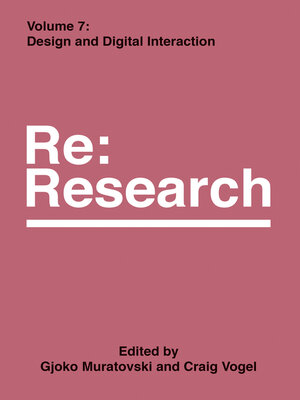
Sign up to save your library
With an OverDrive account, you can save your favorite libraries for at-a-glance information about availability. Find out more about OverDrive accounts.
Find this title in Libby, the library reading app by OverDrive.



Search for a digital library with this title
Title found at these libraries:
| Library Name | Distance |
|---|---|
| Loading... |
Just as the term design has been going through change, growth and expansion of meaning, and interpretation in practice and education – the same can be said for design research. The traditional boundaries of design are dissolving and connections are being established with other fields at an exponential rate. Based on the proceedings from the IASDR 2017 Conference, Re:Research is an edited collection that showcases a curated selection of 83 papers – just over half of the works presented at the conference. With topics ranging from the introduction of design in the primary education sector to designing information for Artificial Intelligence systems, this book collection demonstrates the diverse perspectives of design and design research. Divided into seven thematic volumes, this collection maps out where the field of design research is now.
From Software Engineering to Information Design
Most academic methodologies are developed from a prescribed methodological process that is limited to a specific area of study. However, the disciplinary landscape in which the knowledge is established is being rapidly reconfigured. Given the vast varieties of practices and knowledge base required from information designers, it is even more crucial for them to look outside of the traditional visual design fields and seek diversities for better research and creation methods. The two disciplines, software engineering and information design, are often perceived as one provides technical solutions to the other. This essay intends to move beyond the common perception, and identify relevant issues in software engineering design that resonate with the information design process. The issues include the multi-component planning approach; the human-oriented agile method; design concepts such as abstraction, decomposition, component modularity, hierarchical relationship and extensibility. The perspectives from software engineering design and information design is examined through units of analysis, terminology explanations and forms of communications. The collective design methods and principles provide a systematic framework to the methodological thinking in information design. The discussion serves the purpose of encouraging more conceptual-based conversations between information design and other disciplines, especially in the fields of science and technology.
Designing Information for Artificial Intelligence: Path Recommendation and User Acceptance in a Virtual Space
In this study, the authors propose two information layout strategies (informative layout and decisive layout) that influence the user acceptance rate on recommended information. The informative layout is the degree of descriptions in the recommendation process. The decisive layout is the degree of choices in recommendations. Thus, the objective of the paper is to discover how users' acceptance of a recommendation changes when the recommendation is displayed in different degrees of informative and decisive layouts. To this end, we have conducted the following tasks: (1) sophisticated software was created with JavaScript to conduct experiments with users online; (2) experiment subjects (N=247) with various education and demographic levels were recruited; (3) user acceptance rate depending on the information layout strategy was collected; (4) the relationships between information layout strategy and user acceptance of the recommended information were computationally analyzed. The results of the study indicate that the information layout strategy proposed in this research significantly influences user...







